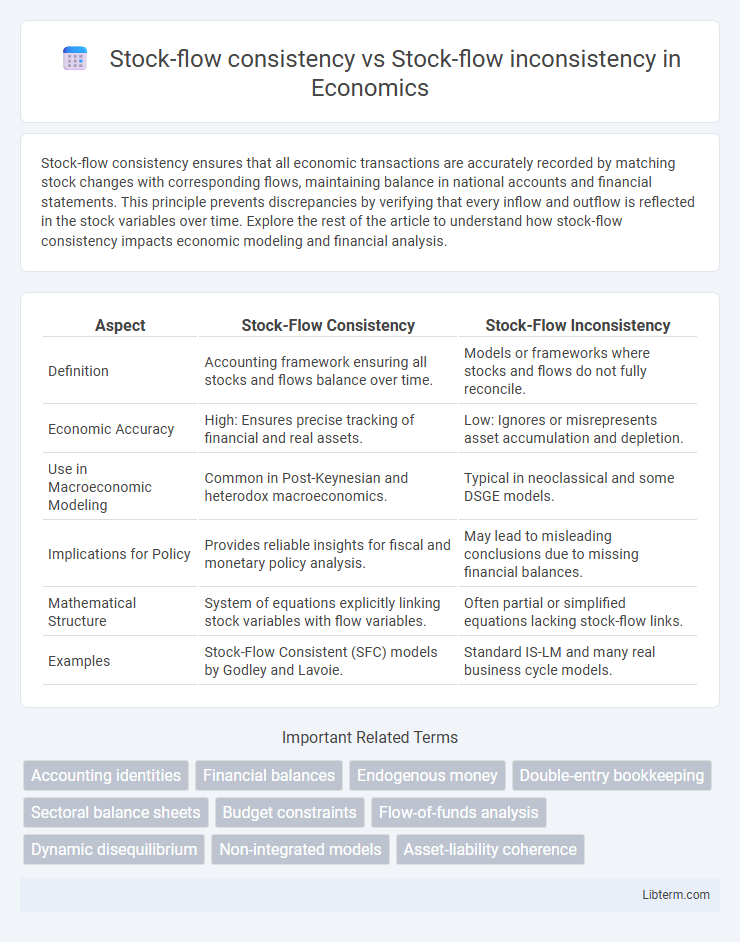Stock-flow consistency ensures that all economic transactions are accurately recorded by matching stock changes with corresponding flows, maintaining balance in national accounts and financial statements. This principle prevents discrepancies by verifying that every inflow and outflow is reflected in the stock variables over time. Explore the rest of the article to understand how stock-flow consistency impacts economic modeling and financial analysis.
Table of Comparison
| Aspect | Stock-Flow Consistency | Stock-Flow Inconsistency |
|---|---|---|
| Definition | Accounting framework ensuring all stocks and flows balance over time. | Models or frameworks where stocks and flows do not fully reconcile. |
| Economic Accuracy | High: Ensures precise tracking of financial and real assets. | Low: Ignores or misrepresents asset accumulation and depletion. |
| Use in Macroeconomic Modeling | Common in Post-Keynesian and heterodox macroeconomics. | Typical in neoclassical and some DSGE models. |
| Implications for Policy | Provides reliable insights for fiscal and monetary policy analysis. | May lead to misleading conclusions due to missing financial balances. |
| Mathematical Structure | System of equations explicitly linking stock variables with flow variables. | Often partial or simplified equations lacking stock-flow links. |
| Examples | Stock-Flow Consistent (SFC) models by Godley and Lavoie. | Standard IS-LM and many real business cycle models. |
Introduction to Stock-Flow Concepts
Stock-flow consistency ensures that all stocks and flows in an economic model are accurately accounted for, maintaining a balance where the change in stock equals the net flow over time. In contrast, stock-flow inconsistency arises when discrepancies occur between stocks and flows, leading to errors in financial and economic analysis. Understanding these concepts is essential for constructing reliable models that reflect real-world economic dynamics accurately.
Defining Stock-Flow Consistency
Stock-flow consistency ensures that all stocks and flows in an economic model are accurately accounted for, maintaining a logical and quantitative relationship between accumulated quantities (stocks) and their changes over time (flows). This concept is crucial for reliable macroeconomic modeling, as it enforces that the inflows and outflows align with changes in financial and real stocks, preventing discrepancies that lead to stock-flow inconsistency. Stock-flow inconsistent models fail to reconcile stocks and flows, resulting in unrealistic representations of economic dynamics and potential errors in policy analysis or forecasting.
Understanding Stock-Flow Inconsistency
Stock-flow inconsistency occurs when the accumulation of stocks does not accurately correspond to the flows recorded over time, leading to errors in economic models or financial statements. Such inconsistencies can distort the assessment of financial health, causing misinterpretations of asset and liability balances. Understanding stock-flow inconsistency is crucial for evaluating the reliability of economic data and ensuring accurate policy analysis or investment decisions.
Core Principles of Stock-Flow Consistent Models
Stock-flow consistent (SFC) models ensure that all stocks and flows in an economic system are accounted for without discrepancies, reflecting accurate interactions between assets, liabilities, and transactions. Core principles include the comprehensive integration of financial and real flows, explicit accounting of every sector's balance sheets, and the rigorous enforcement of accounting identities to prevent any stock-flow inconsistency. This framework facilitates precise analysis of economic dynamics by maintaining the coherence of stocks (such as capital and wealth) and corresponding flows (like income and expenditures) across all agents and sectors.
Common Sources of Stock-Flow Inconsistency
Common sources of stock-flow inconsistency include measurement errors, timing mismatches, and incomplete data reporting, which lead to discrepancies between recorded stocks and corresponding flows in economic models. Inaccurate stock valuation methods and unreported adjustments in flows contribute to inconsistencies that undermine the reliability of financial and macroeconomic analysis. Addressing these issues is crucial for ensuring stock-flow consistent models accurately reflect real-world economic transactions and balance sheets.
Macroeconomic Implications of Stock-Flow Consistency
Stock-flow consistency ensures that all financial stocks and flows in an economy are recorded accurately, preventing discrepancies such as unaccounted debts or assets that can distort macroeconomic analysis. Maintaining stock-flow consistency supports stable fiscal and monetary policies by providing a reliable framework for tracking government deficits, private sector savings, and investment behavior, thus reducing the risk of financial crises. Conversely, stock-flow inconsistency can lead to misinterpretation of economic conditions, causing faulty policy decisions that may exacerbate economic volatility and financial instability.
Risks and Consequences of Stock-Flow Inconsistency
Stock-flow inconsistency occurs when the recorded economic stocks, such as capital or debt, do not align with the corresponding flows, like investments or repayments, leading to inaccurate financial statements. This inconsistency increases the risk of misallocation of resources, financial instability, and systemic crises due to hidden imbalances in assets and liabilities. Persistent stock-flow mismatches can result in misleading economic indicators, exacerbating vulnerabilities in macroeconomic policy and financial sector regulation.
Real-World Examples: Consistency vs. Inconsistency
Stock-flow consistency ensures that all economic transactions and stock changes in a system balance correctly, as exemplified by national accounting frameworks like the System of National Accounts (SNA) used by governments to track GDP and national debt accurately. In contrast, stock-flow inconsistency appears in real-world financial crises, such as the 2008 global financial meltdown, where asset values and debt levels grew out of sync, leading to systemic instability. This imbalance highlights the crucial role of integrating stock and flow variables to maintain economic stability and prevent unsustainable financial bubbles.
Best Practices for Ensuring Stock-Flow Consistency
Ensuring stock-flow consistency requires rigorous accounting frameworks that accurately link flow variables such as income and expenditure to corresponding stock variables like assets and liabilities. Best practices involve implementing integrated balance sheets with real-time data reconciliation, maintaining sectoral financial accounts, and utilizing computational models to detect discrepancies early. Regular audits and cross-validation between stock and flow data enhance transparency and prevent systemic errors in macroeconomic analysis.
Conclusion: The Importance of Stock-Flow Analysis
Stock-flow consistency ensures that all economic transactions and stocks are accurately tracked, preventing imbalances and enabling reliable macroeconomic modeling. In contrast, stock-flow inconsistency leads to flawed data, misrepresenting financial stability and impairing policy decisions. Emphasizing stock-flow analysis is crucial for understanding the dynamic relationship between economic variables and maintaining coherent fiscal and monetary frameworks.
Stock-flow consistency Infographic

 libterm.com
libterm.com